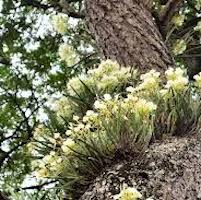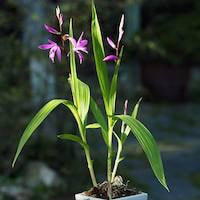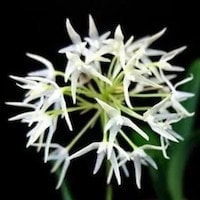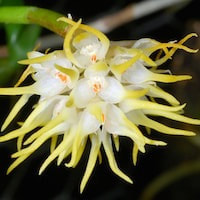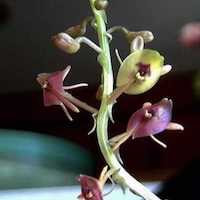Experience Freshness with Fresh 4 Fragrance Oil
Various orchids and scent notes are used in perfume oil in different proportions. One of these orchids is Brassavola Nodosa, also known as Lady of the Night. It has beautiful white to pale green flowers that release a captivating fragrance in the evening. This orchid is easy to grow and adaptable to various conditions. The scent is primarily derived from cineole medicinal, giving it a delightful aroma reminiscent of citronellol and rose. Brassavola Nodosa is a key ingredient in the perfume Fresh 4 (Women) for Team Building Perfume Workshop.
Another orchid used in perfumes is Bletilla striata, commonly referred to as Baiji. In traditional Chinese medicine, the tubers of this orchid are known for their bitter, sweet, and acerbic taste. They are believed to have beneficial effects on the lungs, liver, and stomach meridians. Bletilla striata is utilized in the treatment of various conditions such as swelling, hemorrhages, gastric bleeds, and skin issues. It contains compounds like phenanthraquinone and several antimicrobial agents.
Bulbophyllum laxiflorum, also called Fusheshidou Lan, is another orchid utilized in perfumes. It is believed to have properties that enrich the Yin and benefit the lungs by clearing phlegm and stopping haemoptysis. Found in southeastern China, Myanmar, Thailand, and Peninsular Malaysia, this orchid has a significant presence in perfume compositions.
Bulbophyllum odoratissimum, known as Mihuashidou Lan, contributes its sweet fragrance to perfumes. It is distributed across several regions, including China, Tibet, Nepal, Bhutan, Sikkim, Laos, Vietnam, Thailand, and Myanmar. This orchid is used in herbal remedies for fractures, pulmonary tuberculosis, and hernia pain.
The orchid Crepidium acuminatum, also known as Jeevak or Jivak, is valued in Indian Ayurvedic medicine. Its pseudobulbs are employed in treating bleeding disorders, fever, tuberculosis, dysentery, rheumatism, and insect bites. Crepidium acuminatum is an important ingredient in various formulations, including the popular Ayurvedic tonic "Chyavanprash."
Alongside these orchids, perfumes may incorporate additional scent notes such as pitahaya dragon fruit, aromatic herbs, banana leaf, fig leaf, ginseng, green pepper, marjoram, camphor, fennel, hops, and more. These diverse notes contribute to the overall fragrance composition, resulting in captivating and unique perfumes.
Another orchid used in perfumes is Bletilla striata, commonly referred to as Baiji. In traditional Chinese medicine, the tubers of this orchid are known for their bitter, sweet, and acerbic taste. They are believed to have beneficial effects on the lungs, liver, and stomach meridians. Bletilla striata is utilized in the treatment of various conditions such as swelling, hemorrhages, gastric bleeds, and skin issues. It contains compounds like phenanthraquinone and several antimicrobial agents.
Bulbophyllum laxiflorum, also called Fusheshidou Lan, is another orchid utilized in perfumes. It is believed to have properties that enrich the Yin and benefit the lungs by clearing phlegm and stopping haemoptysis. Found in southeastern China, Myanmar, Thailand, and Peninsular Malaysia, this orchid has a significant presence in perfume compositions.
Bulbophyllum odoratissimum, known as Mihuashidou Lan, contributes its sweet fragrance to perfumes. It is distributed across several regions, including China, Tibet, Nepal, Bhutan, Sikkim, Laos, Vietnam, Thailand, and Myanmar. This orchid is used in herbal remedies for fractures, pulmonary tuberculosis, and hernia pain.
The orchid Crepidium acuminatum, also known as Jeevak or Jivak, is valued in Indian Ayurvedic medicine. Its pseudobulbs are employed in treating bleeding disorders, fever, tuberculosis, dysentery, rheumatism, and insect bites. Crepidium acuminatum is an important ingredient in various formulations, including the popular Ayurvedic tonic "Chyavanprash."
Alongside these orchids, perfumes may incorporate additional scent notes such as pitahaya dragon fruit, aromatic herbs, banana leaf, fig leaf, ginseng, green pepper, marjoram, camphor, fennel, hops, and more. These diverse notes contribute to the overall fragrance composition, resulting in captivating and unique perfumes.
Download the guided mediation that works best with this Orchid fragrance oil
| women_fresh_essential_oil_orchi_00004.mp3 | |
| File Size: | 233191 kb |
| File Type: | mp3 |
The Power of Orchids Unleashed
Contains Scented Notes of following in various proportions:
Native Singaporean Orchid notes: Brassavola Nodosa
|
Brassavola Nodosa - Used in Fresh 4 (Women) for Team building Perfume workshop
Brassavola Nodosa, commonly known as Lady of the Night, is a captivating orchid with white to pale green flowers. These flowers, typically around 3½ inches in diameter but occasionally reaching up to 6 inches, emit a wonderful fragrance in the evening. Growing Brassavola Nodosa is relatively easy, as it adapts well to a wide range of cultivation conditions. Even a single flower spike can be incredibly rewarding, but a large specimen plant can produce dozens of flowers, creating a stunning display. It is highly likely that you have encountered these beautiful orchids growing on trees around town. The fragrance of Brassavola Nodosa is primarily attributed to Cineole Medicinal, which imparts a scent reminiscent of citronellol and rose. The combination of these fragrant notes adds to the allure of this orchid, making it a favorite among orchid enthusiasts. |
Therapeutic Orchid notes:
|
Bletilla striata
Chinese name: Baiji (white mucilaginous root, white chicken), Gangen (sweet root), Baigen (white root), Baijiertou (white hen’s head/ top), Shantianji (mountain frog) Lian Ji Cao. Bak-kup in Hong Kong, Taiwanese (Hokien) dialect: Peh kiu (white ginger) Japanese: Shiran (purple orchid, Japanese Urn Orchid) Korean name: Jaran Vietnamese names: Bach cap; Hua lan tia Bletilla striata, commonly known as Baiji, is distributed in China, Korea, and Japan. Due to its high demand, it is also commercially grown in Guizhou, Yunnan, Jiangxi, and Guangxi, with Guizhou being the largest producer of top-quality Baiji. According to Traditional Chinese Medicine (TCM), Baiji has a taste described as bitter, sweet, and acerbic. Its nature is considered slightly cold, making it beneficial for the lungs, liver, and stomach meridians. In TCM, the tubers of Baiji are recommended to be cut into thin slices or crushed into a fine powder after cleaning and drying. When chewed, they become gluey in texture. The cut surface of the tubers is brittle, translucent-white, and somewhat sticky with a faint odor. The powdered form is slightly yellowish, odorless, and bitter. When mixed with water, the powder turns gluey, so it should be stored in airtight containers. The tubers of Baiji are used in the treatment of swelling and hemorrhage. They have properties that reduce swelling and promote the regeneration of muscle and other tissues. Baiji is given to patients with tuberculosis who cough up blood due to bleeding in bronchiectasis. It also helps with gastric bleeds, bleeding from trauma or burns, bleeding pustules, bleeding ulcers, fissure-in-ano, and skin fissures caused by exposure to cold. Additionally, Baiji is used to treat sores, scaling, and chapped skin. In Vietnam, Baiji is made into an emollient for burns. Baiji contains five antimicrobial agents, including three bibenzyls and two dihydrophenanthrenes. The bibenzyls present in Baiji have compounds such as 4,7-dihydroxy-1-p-hydroxybenzyl-2-methoxy-9,10-dihydrophenanthrene, 3,30-dihydroxy-2060-bis (p-hydroxybenzyl)-5-methoxybibenzyl, and 2,6-bis(p-hydroxybenzyl)-305-dimethoxy-3-hydroxybibenzyl. The two dihydrophenanthrenes found are 3,30-dihydroxy-5-methoxy-2,506-tris (p-hydroxybenzyl) bibenzyl and 4,7-dihydroxy-2-methoxy-9,10-dihydrophenanthrene. Additionally, Baiji contains four active bacterial compounds: p-hydroxybenzoic acid, protocatechuic acid, p-hydroxybenzaldehyde, and cinnamic acid. These compounds show predominant activity against Gram-positive bacteria and certain fungi. Scientists have discovered an antihelminthic substance in the tubers of B. striata growing on the Korean peninsula, which is effective against Clonorchiasis. Clonorchiasis is a disease caused by consuming raw freshwater fish or snails infected with the encysted cercaria of the liver fluke. This disease can lead to various complications, including cholecystitis, bile duct obstruction, cirrhosis of the liver, and an increased risk of cholangiocarcinoma. Researchers have also developed a novel gene carrier using bioactive glucomannan, a polysaccharide isolated from B. striata (BSP). In experiments, this gene carrier successfully inhibited the expression of TNF-alpha, and scientists anticipate that it could be capable of delivering antisense nucleotides for anti-inflammatory therapy. Moreover, the conjugated B. striata polysaccharide shows promise as a delivery system for cytotoxic agents to treat tumors. It is even used as an embolization agent for the treatment of unresectable liver tumors. |
|
Bulbophyllum laxiflorum Syn. Bulbophyllum radiatum
Chinese names: Fusheshidou Lan (radiating stone bean orchid); Yashe Lan (Duck tongue orchid) Chinese medicinal names: Shizao (Stone date); Shiduo (stone bean); Yanduo (stone bean); Jinduo (golden date); Shimi (Stone rice); Duyiyanzhu (Single leaf cliff pearl) Bulbophyllum laxiflorum, also known as Fusheshidou Lan (radiating stone bean orchid) or Yashe Lan (Duck tongue orchid) in Chinese, has several medicinal names such as Shizao (Stone date), Shiduo (stone bean), Yanduo (stone bean), Jinduo (golden date), Shimi (Stone rice), and Duyiyanzhu (Single leaf cliff pearl). This orchid is found in southeastern China, Myanmar, Thailand, and Peninsular Malaysia. In Chinese medicine, B. laxiflorum is believed to enrich the Yin and provide benefits to the lungs by clearing phlegm and stopping haemoptysis (coughing up blood). It is also known to help the stomach by improving appetite, aiding digestion, and relieving dry throat. The medicinal properties of B. laxiflorum make it valuable in traditional Chinese medicine for respiratory and digestive health. |
|
Bulbophyllum odoratissimum
Chinese names: Mihuashidou Lan (small flow- ered stone bean orchid), Xiaohaoshi Ganlan (small stone olive), Shimi (stone rice); Mitoushidou Lan (dense head stone bean orchid) Medicinal name: Guoshangye (leaves on fruit); Xiaoguoshangye (small Guoshangye); Shicuanlian (rock string lotus) Myanmar name: Thazin hmwe Bulbophyllum odoratissimum, known as Mihuashidou Lan (small-flowered stone bean orchid), Xiaohaoshi Ganlan (small stone olive), Shimi (stone rice), or Mitoushidou Lan (dense head stone bean orchid) in Chinese, has medicinal names including Guoshangye (leaves on fruit), Xiaoguoshangye (small Guoshangye), and Shicuanlian (rock string lotus). It is also referred to as Thazin hmwe in Myanmar. This orchid is distributed in China, Tibet, Nepal, Bhutan, Sikkim, Laos, Vietnam, Thailand, and Myanmar. It flowers during different periods in various regions, such as April to August in China, April to June in Myanmar, May to September in Bhutan, and May to July in Thailand. The flowers of Bulbophyllum odoratissimum emit a sweet and pleasant fragrance. In herbal prescriptions, Bulbophyllum odoratissimum is used for various purposes:
|
|
Crepidium acuminatum (D. Don.) Szlach. Syn. Malaxis acuminata D. Don., Microstylis wallichii Lindl.
Indian names: Jeevak in Hindi, Jivak (Tamil), Jivakam (Malayalam), Jivakam (Tekugu, Jivakamu (Kannada), Jivaka (Sankrit): Lahsunia(vernacular name in Kumaun Himalaya) Ayurvedic names: Jivak, Rishvak, Rishbhaka, Bandhura, Dhira, Durdhara, Gopati, Indraksa, Kakuda, Matrika, Visani, Vrisa, Vrisnabha Crepidium acuminatum, also known as Jeevak in Hindi, Jivak in Tamil, Jivakam in Malayalam and Telugu, Jivakamu in Kannada, Jivaka in Sanskrit, and Lahsunia in the vernacular name of Kumaun Himalaya, is a plant of medicinal significance. The pseudobulbs of Crepidium acuminatum are used in Ayurvedic medicine to address various health conditions. They are employed in the treatment of bleeding disorders, fever, tuberculosis, sensations of heat, emaciation, dysentery, rheumatism, and insect bites. This plant is an integral part of the Ayurvedic tonic called "Chyavanprash," a renowned herbal preparation used for promoting overall health and preventing illnesses. Crepidium acuminatum, or Jeevak/Jivak, is included in several Ayurvedic formulations, such as Astavargha churna, Chyanprash rasayan, Chitrakadi taila, Vachadi taila, Mahakalyan ghrita, Mahamayura ghrita, Mahapadma taila, Jivaniya ghrita, Vajkaran ghrita, Brahini gutika, and Himvana agada. In instances where C. acuminatum is not available, Malaxis cylindrostachya and Malaxis mackinnoni are sometimes used as substitutes. Other alternatives include Pueraria tuberosa (Vidara kand), Centaurea behen (Safed behmen), Centaurium roxburghii (Lal behmen), and Tinospora cordifolia (Guruchi). |
Other scent note
Pitahaya dragon fruit, aromatic herbs, banana leaf, Fig leaf, Ginseng, Green Pepper, Marjoram, Camphor, Fennel, Hops
Scentopia Library Reference ingredient
Patchouli - Check details at Scentopia's scent library
Join Scentopia's wonderful orchid scent crafting, fragrance tour, bridal shower or corporate team building which includes perfume making onsite and offsite, beach activities and more. We also serve primary school learning journey, secondary students and pupil on industrial excursions. Know more about our orchids perfume bar or therapeutic orchid scents and other wellness aromas. Conatct Perfume workshop or book a scent crafting session here.
